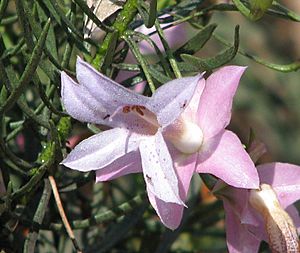Spotted poverty bush facts for kids
Quick facts for kids Spotted poverty bush |
|
|---|---|
 |
|
| E. abietina in Burnley Gardens, Burnley, Victoria | |
| Scientific classification | |
| Genus: |
Eremophila (plant)
|
| Species: |
abietina
|
Eremophila abietina, also known as spotted poverty bush, is a special plant found only in a few dry areas of Western Australia. It belongs to the figwort family. This plant is a stiff, upright, and very sticky shrub. It has unique dark bluish-green leaves and pale flowers with purple spots.
Contents
About the Spotted Poverty Bush
The spotted poverty bush is a stiff, woody, and very sticky shrub. It usually grows to be about 0.5 to 2.5 meters (1.6 to 8.2 feet) tall. It can also be just as wide.
Leaves and Flowers
Its leaves grow very close together. They are sticky because of a natural substance called resin. The leaves are long and thin, measuring 10 to 45 millimeters (0.4 to 1.8 inches) in length. They are also 0.7 to 4.5 millimeters (0.03 to 0.18 inches) wide. Even though they have tiny hairs, the resin often covers them.
The flowers grow one by one where the leaves meet the stem. Each flower sits on a flat stalk that is 15 to 25 millimeters (0.6 to 1.0 inch) long. The outer parts of the flower, called sepals, overlap. They are cream to reddish in color and are 13 to 15 millimeters (0.5 to 0.6 inches) long. After the flower blooms, these sepals grow even longer, up to 18 to 23 millimeters (0.7 to 0.9 inches). They stay on the plant for a long time.
The main part of the flower, made by the petals, forms a tube. This tube is 25 to 35 millimeters (1.0 to 1.4 inches) long. It is usually bluish-green to pale purple. The ends of the petals have purple spots.
When it Blooms and Fruits
This plant blooms between June and October. After the flowers, it produces fruits. These fruits are dry and shaped like an oval or a cone. They have a distinct pointed tip.
How it Got its Name
The spotted poverty bush was first officially described in 1925 by a scientist named Fritz Kraenzlin. He published his description in a science journal called Bulletin of Miscellaneous Information. The first plant sample used for this description was found near Laverton.
Meaning of the Name
The plant's scientific name, abietina, comes from the word Abies. This is because its leaves look a lot like the leaves of fir trees.
Different Types of Eremophila abietina
In 2007, another scientist named Robert Chinnock found two slightly different types of this plant. These are called subspecies:
- Eremophila abietina subsp. abietina: This type has shorter, narrower leaves that are almost round. Its flowers are also brighter.
- Eremophila abietina subsp. ciliata: This type has flatter leaves with hairs along their edges. It tends to grow a bit further south.
Where the Plant Lives
The spotted poverty bush grows in specific places in the Great Victoria Desert near Laverton. You can find it on flat areas covered with small, shiny rocks called gibber plains. It also grows on chalky flats and rocky areas made of jasper.
Plant and Animal Interactions
Some native bee species visit the spotted poverty bush. They collect a waxy substance from the plant's flower buds and other parts. Bees use this wax to make propolis, which is like a glue for their hives. Sometimes, this collecting can harm the plant and make it grow less.
Growing Spotted Poverty Bush
The spotted poverty bush can be a slow-growing plant in a garden. However, it makes up for this by living a long time. It grows best in soil that drains water well and in a sunny spot. It can also handle a little bit of shade.
Care and Appearance
This plant can only handle light frosts. If it gets damaged by frost, it usually recovers well after being trimmed. The metallic colors of its flowers and the sepals that stay on the plant make it very attractive.
How to Grow New Plants
It can be tricky to grow new spotted poverty bush plants from seeds or cuttings. Because of this, most plants grown in gardens are made by grafting. This means a piece of the spotted poverty bush is attached to another plant, usually a Myoporum, which helps it grow better.
Conservation Status
The Government of Western Australia's Department of Parks and Wildlife has looked at the spotted poverty bush. They have classified it as "not threatened." This means there are enough of these plants in the wild, and they are not in danger of disappearing.
Images for kids
-
E. abietina habit (in the Australian Botanic Garden Mount Annan)


